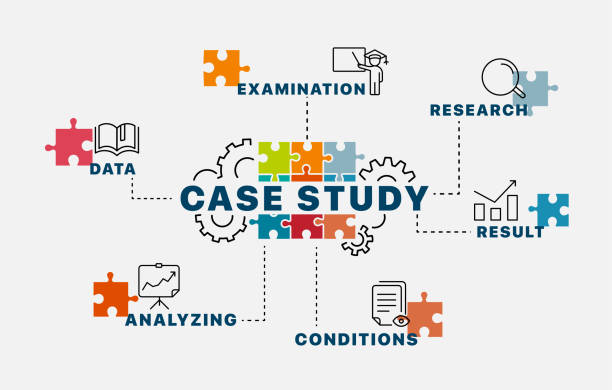
Case studies serve as microcosms of real-world scenarios, allowing individuals to apply theoretical knowledge to practical situations. For fresh graduates and postgraduates stepping into the professional world, the skill of solving case studies is pivotal, often tested in interviews and crucial for roles requiring adept problem-solving abilities. This comprehensive guide aims to delve deeply into the essential steps required to master the craft of case study analysis.
Understanding the Case
The initial step in tackling a case study is to absorb its essence thoroughly. Read the case multiple times, dissecting and highlighting key information, facts, and figures. Understanding the context, identifying stakeholders, and grasping the central problem or challenge presented are vital to proceeding effectively.
Reading with Purpose
The cornerstone of understanding a case study lies in repeated readings with an intent to extract layers of information. The first reading may provide a surface-level understanding, but subsequent readings unveil hidden nuances and intricacies. Each pass through the case presents an opportunity to identify and highlight key information, facts, and figures that contribute to the central theme.
Contextual Comprehension
Context is the bedrock upon which the entire analysis is built. Understanding the context involves placing the case within its relevant industry, market dynamics, or social framework. It’s about comprehending the historical background, current circumstances, and potential future implications. Contextual comprehension aids in connecting the dots, revealing underlying patterns, and recognizing the significance of various elements within the case.
Identifying Stakeholders
Every case involves individuals, groups, or entities affected by or influencing the situation. Identifying these stakeholders is crucial as it sheds light on vested interests, motivations, and potential alliances or conflicts. Stakeholders could range from individuals directly involved in the issue to broader entities like customers, competitors, regulators, or societal groups. Understanding their perspectives and roles is instrumental in formulating a holistic analysis.
Grasping the Central Problem or Challenge
At the heart of every case study lies a core issue or challenge waiting to be unravelled. This pivotal problem often manifests as a symptom of deeper-rooted issues. Grasping this central problem requires a keen eye for detail and the ability to discern between surface-level manifestations and underlying causes. It involves asking probing questions, exploring various angles, and narrowing down to the fundamental issue that demands resolution.
Analyzing the Situation
Once the case is understood, the next step involves analyzing the situation using frameworks or models relevant to the industry or subject matter. SWOT analysis, PESTLE analysis, or Porter’s Five Forces are common frameworks aiding in structuring thoughts and systematically dissecting the problem at hand.
Frameworks like SWOT (Strengths, Weaknesses, Opportunities, Threats) provide a structured approach to assessing internal and external factors influencing the case. It enables a comprehensive evaluation of the organization’s strengths and weaknesses, as well as the opportunities and threats present in its environment.
Similarly, PESTLE analysis (Political, Economic, Social, Technological, Legal, Environmental) offers a broad perspective by examining the macro-environmental factors impacting the case. This framework aids in understanding the external influences that might affect the organization or situation under scrutiny.
Porter’s Five Forces model focuses on industry dynamics, analyzing the competitive forces that shape strategy. It delves into factors like the bargaining power of suppliers and buyers, the threat of new entrants, the threat of substitutes, and the intensity of rivalry among existing competitors.
Identifying the Core Issues
Discerning the primary issues or challenges within the case is critical. Distinguish between symptoms and root causes, prioritizing the identified problems based on their impact and relevance to the overall issue. This stage involves rigorous critical thinking and analytical skills.
Generating Solutions
After pinpointing the problems, brainstorm potential solutions. Utilize creativity and critical thinking to devise multiple approaches. Assess the feasibility, practicality, and potential outcomes of each solution proposed.
Having identified the core issues within a case study, the pivotal phase of generating solutions commences. This stage requires a blend of creativity and critical thinking, prompting individuals to brainstorm a spectrum of potential remedies. By leveraging imaginative thinking and analytical prowess, multiple approaches are explored and evaluated in terms of feasibility, practicality, and anticipated outcomes.
Unleashing Creativity and Critical Thinking
Brainstorming sessions serve as the breeding ground for diverse solutions. Encouraging a free flow of ideas, without inhibition, fosters the exploration of unconventional yet viable approaches. Here, creativity plays a vital role, allowing individuals to think beyond the obvious and conventional solutions. It encourages the generation of innovative ideas that could potentially address the identified problems.
Assessing Feasibility and Practicality
Amidst the array of proposed solutions, a pragmatic evaluation becomes imperative. Assessing the feasibility and practicality of each solution weeds out ideas that might seem appealing but lack viability in real-world application. Considerations of resource availability, time constraints, and compatibility with the organization’s objectives aid in filtering out solutions that may not be implementable.
Anticipating Potential Outcomes
Each proposed solution undergoes a rigorous analysis of its potential outcomes. This involves forecasting the short-term and long-term consequences, both positive and negative, that could stem from its implementation. Anticipating these outcomes assists in gauging the potential impact of the solutions on various stakeholders and the overall scenario.
Encouraging Diverse Perspectives
Embracing diverse perspectives and opinions during the solution-generation phase enriches the pool of ideas. Different viewpoints offer fresh insights and alternative angles that might have been overlooked initially. Collaborative brainstorming sessions or seeking input from varied experts fosters a more comprehensive exploration of solutions.
Iterative Approach
The process of generating solutions is rarely linear. It often involves iterative cycles of brainstorming, evaluation, refinement, and re-evaluation. Ideas evolve, merge, or get discarded based on continuous scrutiny and improvement, leading to more refined and viable solutions.
Evaluation and Decision Making
Evaluate each solution against predefined criteria. Assess the risks, benefits, and implications associated with each option. Employ a rational decision-making process to choose the most viable solution or a combination of solutions.
There are several tools and methodologies available to evaluate the solutions proposed to solve a case study. These tools aid in assessing the effectiveness, feasibility, and potential outcomes of the chosen solution(s). Here are some commonly used evaluation tools:
Cost-Benefit Analysis (CBA): This tool compares the costs associated with implementing a solution to the benefits it is expected to generate. It quantifies both the tangible and intangible costs and benefits to ascertain whether the solution is financially viable.
Risk Assessment Matrix: It helps in evaluating the potential risks associated with each solution. By considering the likelihood and impact of various risks, this matrix assists in identifying and mitigating potential pitfalls.
SWOT Analysis (Strengths, Weaknesses, Opportunities, Threats): Although commonly used in the initial analysis phase, SWOT analysis can also be employed to evaluate solutions. It assesses the solution’s alignment with organizational strengths, weaknesses, opportunities, and threats, providing a holistic view of its fit within the context.
Decision Matrix: This tool involves creating a matrix that weighs different criteria important for evaluating solutions. Each criterion is given a weighted score, and solutions are rated against these criteria, facilitating an objective comparison of different solutions.
Impact Analysis: It assesses the potential impact of the solution on various aspects such as stakeholders, operations, finances, and the overall organization. This analysis predicts and evaluates the consequences, both positive and negative, of implementing the solution.
Feasibility Study: Conducting a feasibility study helps in evaluating whether the solution is technically, economically, and operationally feasible. It considers factors like technological requirements, resource availability, and practicality in the given context.
Key Performance Indicators (KPIs) Measurement: Establishing KPIs relevant to the solution enables tracking and measuring its success. These indicators serve as benchmarks to evaluate the solution’s performance against predefined goals and objectives.
Stakeholder Analysis: Evaluating the impact of the solution on different stakeholders helps in understanding their perspectives and assessing the acceptability and support for the proposed solution.
Scenario Planning: This involves creating different scenarios to forecast potential outcomes of implementing the solution under varying conditions. It assists in preparing for different eventualities and uncertainties.
Peer Review or Expert Opinion: Seeking feedback and opinions from subject matter experts or peers can provide valuable insights and alternative viewpoints, contributing to a more comprehensive evaluation of the solution.
Communication and Presentation
The ability to articulate the analysis and proposed solutions is as crucial as the analysis itself. Develop a structured and coherent presentation. Clearly communicate the thought process, methodology, and reasoning behind the chosen solution. Utilize data, charts, and relevant information to substantiate conclusions.
Continuous Learning and Improvement
Seek feedback after presenting solutions. Embrace constructive criticism to refine the approach. Learning from both successful and unsuccessful attempts at solving case studies is integral to continuous improvement in analytical skills.
Practical Application
Regularly practice solving case studies. Engage in mock interviews, participate in study groups, or enroll in workshops dedicated to case study analysis. Real-life exposure enhances the ability to handle diverse scenarios effectively.
Mastering the art of solving case studies is a culmination of analytical skills, critical thinking, and effective communication. As fresh graduates and postgraduates venture into the professional world, honing these skills becomes indispensable in navigating complex problem-solving situations.
By following the outlined steps and consistently practicing case study analysis, graduates can enhance their problem-solving abilities, distinguishing themselves in interviews and professional environments where case studies play a pivotal role in decision-making processes.
Remember, case study analysis is not solely about finding a solution; it encompasses the journey of critical thinking, analysis, and effectively communicating your thought process—an invaluable skill set applicable across various career paths.
admin
Related Posts

Benefits of Pursuing D.Pharma After 12th: Career Opportunities and Scope – Geeta University
Benefits of Pursuing D. Pharma After 12th: Career Opportunities and Scope– Geeta University Choosing a career path after completing high school can be a daunting

What is better, BCA+MCA or B.Tech(CS)? – Geeta University
What is better, BCA+MCA or B.Tech(CS)? – Geeta University Choosing the right course after completing 12th grade can be a daunting task. With so many
Artificial Intelligence: A Novel Phase of Intelligent Agriculture – A Review
Abstract Agriculture is the foundation of all nations and the main driver of world’s economy. It makes a substantial contribution to India’s gross domestic product


